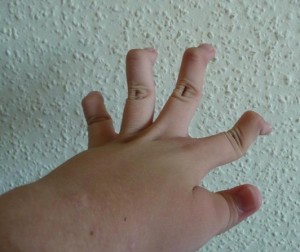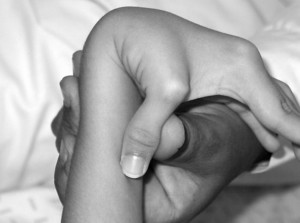What is Ehlers-Danlos Syndrome ?
The syndrome refers to a group of rare, inherited abnormalities that affect the connective tissues, mainly the joints, skin and the walls of the blood vessels.
Collagen is a major constituent of connective tissue. The production of collagen is disturbed in patients with Ehlers-Danlos syndrome. There are many types of Ehlers-Danlos syndrome and each one has distinctive symptoms. However, all of them affect the joint, while some may affect the skin. It does not affect functions of the brain.
Some of the major symptoms of Ehlers-Danlos syndrome loose, flexible joints with a range of motion and extension that is greater than normal, and delicate, stretchy skin. Complications that result from Ehlers-Danlos syndrome can be very debilitating for the patient.
Symptoms of Ehlers-Danlos syndrome
The severity of Ehlers-Danlos syndrome signs and symptoms tend to differ greatly from one affected person to another. The primary signs include:
- Presence of delicate, elastic skin
- The presence of flexible, loose joints
The symptoms may also vary as pert the many types of Ehlers-Danlos syndrome. They are discussed below:
- Classical type Ehlers-Danlos syndrome (formerly known as type I and type II): It occurs 1 in every 10000 to 20000 individuals. The symptoms are as follows:
- Presence of very smooth and elastic skin
- The joints are loose
- The skin is very delicate which easily tears and bruises
- The healing of wounds is slow which causes widespread scarring
- Redundant skin folds, such as on the eyelids
- Presence of unnecessary skin folds, like those on the eyelids
- Pressure regions such as knees and elbows mat develop benign fibrous tumors. The forearms and shins may develop fatty growths.
- Abnormalities of the heart valve such as aortic root dilation and mitral valve prolapse.
- Presence of muscle pain and fatigue
- Hypermobility type Ehlers-Danlos syndrome (formerly known as type III): It occurs in an estimated 1 in every 10,000 to 15,000 individuals. The symptoms are as follows:
- Presence of unstable and loose joints, which are prone to dislocations
- Muscle pain and fatigue
- The skin easily bruises
- Persistent degenerative joint disease
- Problems of the heart valve such as aortic root dilation and mitral valve prolapse may be present.
- Premature, advanced osteoarthritis accompanied by chronic pain
- Vascular type Ehlers-Danlos syndrome (formerly known as type IV): It is rare, but really dangerous. It occurs in approximately 1 in every 100,000 to 200,000 individuals. The symptoms are as follows:
- Presence of translucent, thin skin that is prone to easy bruising
- Presence of fragile organs and blood vessels which can easily rupture or tear
- Distinct facial features such as thin lips and nose, small chin, bulging eyes and sunken cheeks.
- Heart valve abnormalities such as mitral valve prolapsed, etc.
- The lung may be collapsed
- Other types of Ehlers-Danlos syndrome
- The other types of Ehlers-Danlos syndrome are not defined properly. Also, they are very rare and only a few such cases in some families have been identified.
Some of the complications that result from Ehlers-Danlos syndrome are mentioned below:
- Surgical wounds may have a difficult time in healing. The stitches may either rupture or the healing may not be complete
- It can result in prominent and widespread scarring
- There may dislocation of joints
- Chronic and persistent pain of the joints
- Exposure to sun may result in premature aging of skin
- Early onset arthritis is also possible
- A few individuals with Ehlers-Danlos syndrome may develop osteoporosis
- Individuals with vascular type of Ehlers-Danlos syndrome may be at increased risk to blood vessel and organ rupture, which can be fatal.
Causes of Ehlers-Danlos syndrome
Ehlers-Danlos syndrome is caused due to the various genetic mutations which result in the disruption of collagen production. The genetic mutations are generally passed on from one generation to another. Collagen is type of fibrous protein that is responsible for providing elasticity and strength to the connective tissues present in the tendons, the skin, the organs, the ligaments, blood vessel walls, cartilage and the rest of the body. The enzyme activity is changed due to the presence of genetic mutations which cause the connective tissue to become unstable and weak.
Ehlers-Danlos syndrome has an autosomal dominant pattern of inheritance, which means that a single copy of the mutated gene, passed on from either parent, is sufficient to cause the disorder. An individual with Ehlers-Danlos syndrome has a fifty percent chance of conceiving a child with the syndrome.
Ehlers-Danlos Syndrome Treatment
Ehlers-Danlos syndrome has no known cure. The treatment is aimed at reducing the signs and symptoms as well as preventing the complications that arise due to the condition.
Some of the treatments include:
- Topical anesthetics,, non-steroidal anti-inflammatory drugs and other medications may be prescribed by the doctor for alleviation of joint and muscle pain
- Physical and occupational therapy is recommended to aid the strengthening of muscles, reduce muscle fatigue and stabilize the joints
- Since healing is a difficult process in patients with Ehlers-Danlos syndrome, surgery is performed only in rare cases such as persistent joint dislocations
Ehlers-Danlos Syndrome pictures


